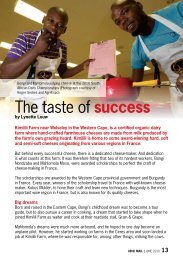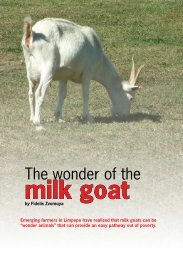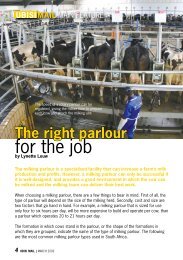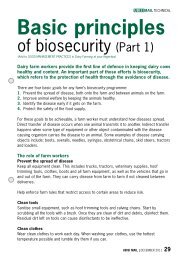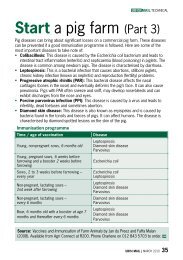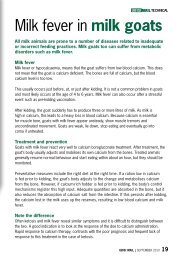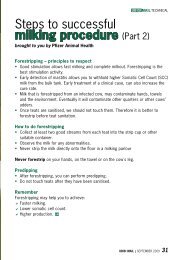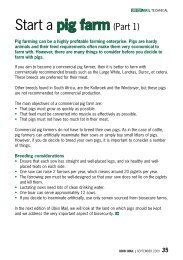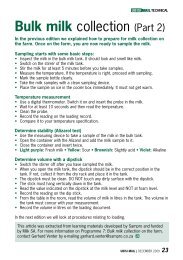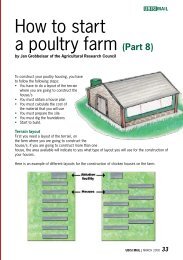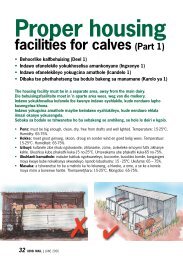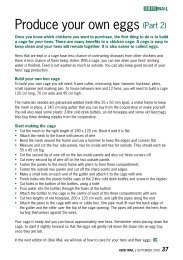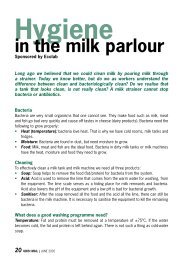Understanding symptoms of -abnormal feeding - Ubisi Mail Magazine
Understanding symptoms of -abnormal feeding - Ubisi Mail Magazine
Understanding symptoms of -abnormal feeding - Ubisi Mail Magazine
You also want an ePaper? Increase the reach of your titles
YUMPU automatically turns print PDFs into web optimized ePapers that Google loves.
<strong>Understanding</strong> <strong>symptoms</strong><br />
<strong>of</strong> <strong>abnormal</strong> <strong>feeding</strong><br />
Often we see animals lying down that are not able to stand up on their<br />
own. They might be lying because they are sick or have walked a long<br />
distance. The problem is not necessarily with their feet. There are<br />
differently diseases and conditions that can result in recumbent animals<br />
(animals lying down).<br />
If only one animal is recumbent, then individual attention can be given. However, if<br />
most animals in the herd are recumbent, the possibility <strong>of</strong> plant poisoning, feed related<br />
problems, water source problems or an outbreak <strong>of</strong> a disease should be investigated.<br />
Many other things can also cause recumbent animals.<br />
Malnutrition<br />
This is a condition where livestock get too little feed or poor quality feed or both. It is<br />
mostly seen during dry winter periods and droughts. It <strong>of</strong>ten occurs where the veld is<br />
overgrazed.<br />
Pregnant cows have high demand for nutrients and they will be more severely affected.<br />
Poor quality feed does not have the protein and energy need to maintain the good<br />
condition <strong>of</strong> the animals. The animals gradually lose weight until they are too weak to walk<br />
short distances or even stand.<br />
Animals that are suffering from malnutrition are at risk <strong>of</strong> being affected by other diseases<br />
because their defence mechanism is weakened. Good food, properly taken will benefit man<br />
and beast, therefore how food is taken is as important as the type and quality <strong>of</strong> food taken.<br />
Examination <strong>of</strong> the animals’ appetite<br />
Cattle that eat lustfully and contently are an indication that there is nothing or very little the<br />
matter with them. On the other hand, if cattle are given tempting, nutritional food and they<br />
don’t eat or eat very unwillingly, then it is a sure sign that something is wrong.<br />
Examination <strong>of</strong> the animals’ excretions<br />
By examining the dung and urine <strong>of</strong> cattle, we can also determine whether their condition<br />
is healthy or not. Blood in the urine or a very dark colour, as well as cow dung that is very<br />
waterish and light <strong>of</strong> colour (for example pale green) are signs <strong>of</strong> ill health.<br />
Summary<br />
One should learn to monitor the health <strong>of</strong> the cattle herd by looking at the animals’<br />
behaviour. It is important to practice the skill <strong>of</strong> noticing a sick animal, identifying the<br />
<strong>symptoms</strong> accurately and knowing what treatment to apply. This is important for the<br />
proper care <strong>of</strong> the herd and the pr<strong>of</strong>itability <strong>of</strong> the farming operation.<br />
32 UBISI MAIL | JUNE 2011
Abnormal <strong>feeding</strong><br />
Malnutrition: Too little or poor quality feed; <strong>of</strong>ten occurs during dry winters, droughts, and<br />
because <strong>of</strong> overgrazed veldt; animals lose weight, are too weak to walk or stand; leads to<br />
weak immunity.<br />
Treatment and prevention:<br />
Give nutritious food, clean water.<br />
Look:<br />
• Cow doesn’t eat: sick.<br />
• Cow can’t stand up: sick, tired from walking, sore feet.<br />
• One or more cows can’t stand up: outbreak <strong>of</strong> disease, plant poisoning, feed or water<br />
problems, malnutrition.<br />
Examine:<br />
• Urine: blood in urine or dark colour.<br />
• Dung: watery and pale green.<br />
TECHNICAL<br />
Ongewone eetgewoontes<br />
Wanvoeding: te min voer <strong>of</strong> voer van lae gehalte; gebeur maklik tydens droë winters, droogtes<br />
<strong>of</strong> op oorbeweide veld; diere verloor gewig en is te swak om te loop <strong>of</strong> te staan; lei tot<br />
swak immuniteit.<br />
Behandeling en voorkoming: Gee voedsame voer, skoon water.<br />
Kyk:<br />
• Koei eet nie: siek.<br />
• Koei kan nie staan nie: siek, moeg geloop, seer pote.<br />
• Een <strong>of</strong> meer koeie kan nie staan nie: siekte in die trop, plantvergiftiging, probleme met<br />
voer <strong>of</strong> water, wanvoeding.<br />
Ondersoek:<br />
• Urine: bloed in urine <strong>of</strong> donker kleur.<br />
• Mis: waterig en vaalgroen.<br />
Ukudla ngendlela engafanele<br />
Ukungondleki kahle: Ukudla okuncane kakhulu noma kwezinga elingelihle; phakathi<br />
nobusika obomile, isomiso, amadlelo aklabiswa ngokweqile; imfuyo iyehla ngesisindo, ibe<br />
buthaka ukuba ingahamba noma ime; isimiso somzimba sokuzivikela esibuthaka.<br />
Ukwelapha nokuvikela izifo: Nikeza ukudla okunomsoco, amanzi ahlanzekile.<br />
Bheka:<br />
• Inkomo ayidli: iyagula.<br />
UBISI MAIL | JUNE 2011 33
TECHNICAL<br />
• Inkomo ayikwazi ukusukuma: iyagula, ikhathele ukuhamba, izinyawu zibuhlungu.<br />
• Inkomo eyodwa noma ezengeziwe azikwazi ukusukuma: kuqhume isifo esithile,<br />
zidle ushevu ezitshalweni<br />
Hlola:<br />
• Umchamo: kunegazi emchanyeni noma kunombala omnyama.<br />
• Ubulongo: bumanzi futhi buluhlaza ngokuphaphathekile.<br />
Ukondla okungaqhelekanga<br />
Ukungondleki: ifula elincinci kakhulu okanye lomgangatho ophantsi; ngexesha lobusika<br />
obomileyo, iimbalela, amadlelo abhuqiweyo; izilwanyana zehla egazini, azinamandla kakhulu<br />
ukuba zingahamba okanye zime; amajoni omzimba ahlaselwa lula zizifo.<br />
Unyango nothintelo: Fumana ukutya okunesondlo, amanzi acocekileyo.<br />
Jonga:<br />
• Inkomo ayityi: iyagula.<br />
• Inkomo ayikwazi ukuma: iyagula, idiniwe kukuhamba,<br />
amanqina abuhlungu.<br />
• Inkomo enye okanye ngaphezulu ayikwazi kuma:<br />
ukuqhambuka kwesifo, ityhefu kwizityalo, iingxaki zefula<br />
okanye zamanzi, ukungondleki.<br />
Xilonga:<br />
• Umchamo: igazi emchameni okanye ibala elimnyama.<br />
• Ubulongwe: Bungamanzi kwaye bupale green.<br />
Phepo e sa tlwaelehang<br />
Phepo e seng ntle: Phepo e nyenyane kapa ya boleng bo fokolang; nakong ya mariha a<br />
ommeng, komello, naha e se e se na jwang ba ho fula; dipho<strong>of</strong>olo di a ota, di a fokola ha di<br />
kgone ho tsamaya le ho ema; boitshireletso ba mmele bo fokolang.<br />
Kalafo le thibelo: Di fe dijo tsa phepo e ntle, metsi a hlwekileng.<br />
Sheba:<br />
• Kgomo ha e je: e ya kula.<br />
• Kgomo ha e kgone ho ema: e ya kula, e kgathetse ka baka la ho tsamaya haholo,<br />
maoto a bohloko.<br />
• Kgomo e le nngwe kapa tse ngata ha di kgone ho ema: sewa sa bolwetse, dimela di<br />
na le tjhefo, mathata a ho fepa kapa a metsi, phepo e seng ntle<br />
Hlahloba:<br />
• Moroto: madi morotong kapa mmala o fifetseng.<br />
• Bolokwe: bo metsi hape bo mmala o botala. UM<br />
34 UBISI MAIL | JUNE 2011



